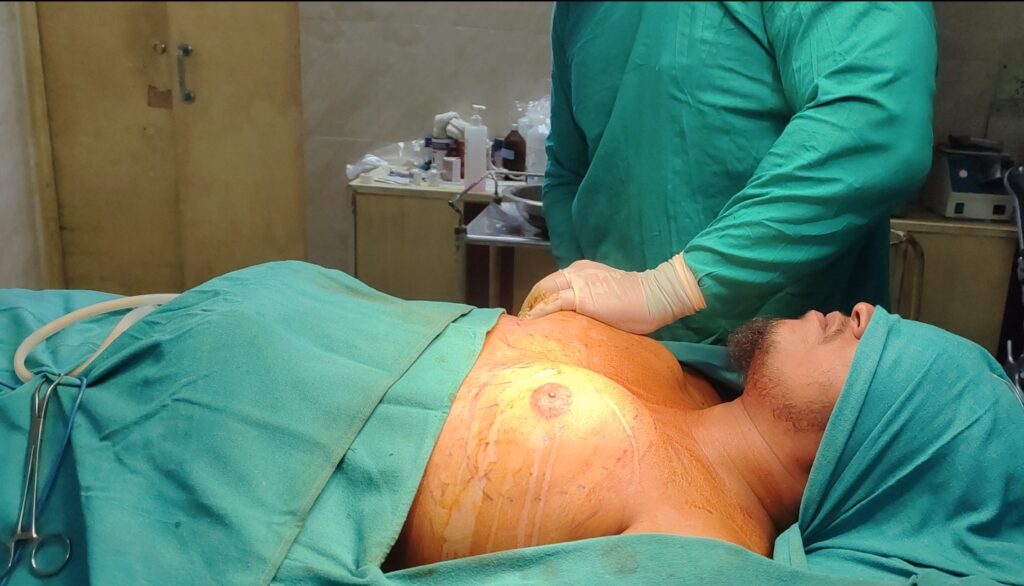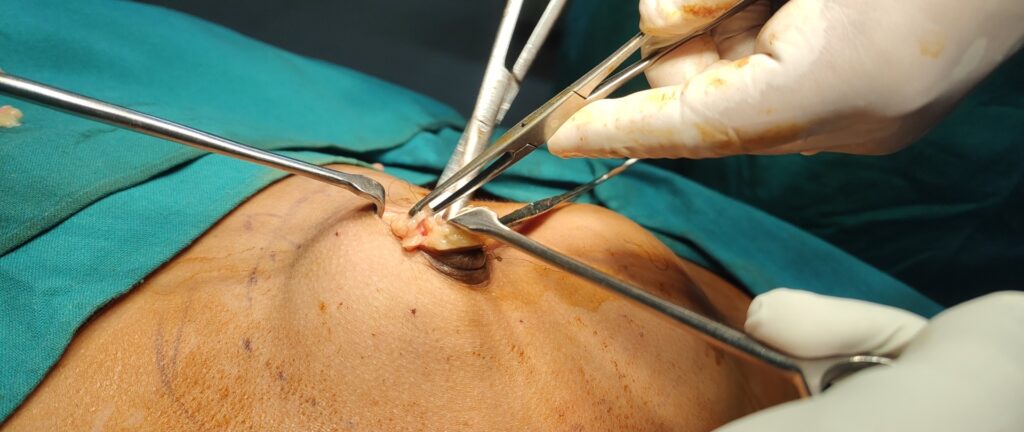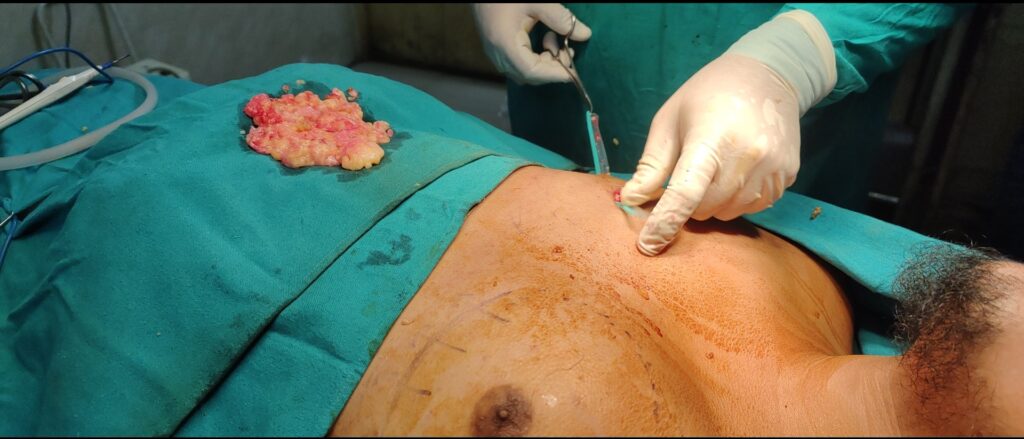Pre-Operative Consultation
Prospective patients will meet Prof. (Dr.) Souvik Adhikari for an initial check-up. He will examine you, check if there are other associated problems, classify your grade of male breasts, propose the surgical plan and highlight any possible complications. It is important to note that the breast enlargement may be asymmetrical in many patients and therefore the surgical plan may vary on the two sides of the chest.
Pre-operative Investigations
Prof. Adhikari will suggest you the appropriate investigations needed to be considered fit for the surgery. This will comprise of a series of blood tests, chest X-ray and ECG. All these tests are done to find out if you have the proper physiological parameters to accept the stress of surgery. Additionally, if there are any latent problems like elevated blood sugar which was not diagnosed earlier then those would be apparent in the reports. If there are any abnormalities then these would be appropriately corrected prior to the surgery.
It is important that you inform Prof. Adhikari about any medications that you might be taking on a regular basis and also of any addictions that you might be having.
Smoking and drinking should be stopped at least 2-3 weeks prior to the surgery. Blood thinners would also need to be stopped for 4-5 days prior to the surgery.
Night Before Surgery
- Have a light diet the night before surgery.
- If you are overtly anxious, you would be recommended an anti-anxiety medication.
- Shave your chest hair, that makes it easier for Prof. Adhikari to outline the markings.
- If you take a medication regularly, you would need to take that unless you have been told not to do the same.
- Do not smoke or drink.
- Get a good sleep, there is nothing to be afraid of!
Morning of Surgery
- If the surgery is planned under general anesthesia, then you cannot take anything by mouth, not even water from the morning.
- If your surgery is planned under local anesthesia, then you can take a light breakfast, there is no restriction in water intake but do not feel bloated.
- Arrive at the facility in time.
- One patient party should accompany you.
- Bring your ID and sign the relevant forms including consent form for surgery.
- Wear loose fitting shirt or T-shirt.
Surgical Process
- Prof. Adhikari will meet you and have a last consultation with you to find out if you have any further queries.
- Next, photographs would be taken from the front and sides.
- After this, markings would be done, the final proposed area of incision and line of scar would be highlighted to you.
- You would then be laid into the operating table and the surgical process would begin.
Components of Surgery
Liposuction
This is done after injecting a solution which has lignocaine which is a local anesthetic which numbs the area along with adrenaline which is a vasoconstrictor which minimizes blood loss during the procedure. This tumescent solution makes the fat softer and makes it amenable to liposuction. Liposuction would be done through small “ports” at the sides of the chest which would result in small scars.

Mastectomy
After most of the fat has been evacuated by liposuction, incisions are made along the proposed lines and the breast tissue is removed keeping a small amount of breast tissue behind the areola to keep the normal shape of the areola and to prevent a “saucer deformity” which might be difficult to correct later on.

Skin Excision
Depending on whether a skin excision is needed, it would be combined with the glandular removal.
Drain Insertion
At the end of the surgical procedure, drains are inserted into the vacant spaces created as a result of excision of the breast tissue. These drains typically come out through the liposuction port sites so that there is no additional scarring.

Compression belt
After dressing, a compression belt would be applied to prevent any blood collecting in the vacant spaces and to decrease the postoperative swelling.
Post-Operative Instructions
- You would be advised antibiotics which you would need to take for a couple of days.
- Pain killers would be advised along with antacids, these can be stopped within a few days when the pain subsides.
- You would need to restrict activities and take rest for at least 1-2 days following the procedure.
- Drains are usually removed 3-4 days after the procedure and the area would then need to be cleaned with soap and water followed by application of an antibiotic cream and re-application of a pressure belt. In select cases, the drains might be kept for a few more days.
- Removal of stitches if needed, would be informed to you.
- Do not smoke or drink for at least 2-3 weeks following the surgery.
- Restrict going to the gym for about 3 weeks after the surgery.
- Prof. Adhikari will be personally guiding you for any problems that you might encounter in the postoperative period.
Possible Complications
You would be given a list of complications in the informed consent form prior to the surgery and you are expected to go through them carefully. Although Prof. Adhikari is extremely experienced with gynecomastia surgery, still, complications can happen even in the best hands. Some complications are highlighted below along with their management –
Hematoma – This is the most frequent complication encountered in patients. Because of the large space produced behind the skin as a result of removal of all of the breast tissue, this space has the propensity of accumulating blood and body fluid as the body does not like open spaces. Add to this the fact that the surgery is done under infiltration with adrenaline which constricts the blood vessels. In the postoperative period, after the effect of adrenaline wears off, these small blood vessels may open up and bleed into the space.
To prevent this, a compression garment is provided which presses on the skin envelope against the muscle thereby sealing off the open space. Also, activities are restricted following surgery. Despite this, in some cases, hematoma may occur.
Small hematomas do not need active management as these are subsequently hemolysed and absorbed by the body. Large ones need drainage through the drain port site if the port mouth is blocked with a clot and the blood cannot come out.
Wound breakdown – Sometimes, the incision at the inferior areolar margin opens up and the stitches give away. This is particularly seen in patients who develop a small collection in their chest and the collection tracks its way out through the areolar margin instead of through the drains as the drain post might be blocked. This is also caused by a limited necrosis of the margin of the areola. Whatever the cause might be, it is not alarming in most cases and resolves with regular cleaning and dressing only. In a few cases, stitches have to be applied again. This usually does not affect the final result.
Asymmetric swelling – This can happen as there can be a difference in healing progression in the 2 sides. Very frequently, there might be a collection on one side while the other side heals without the same. Whatever might be the cause, the final result is not hampered in any way as the body eventually heals itself. Large collections on one side might need to be drained so as to achieve quicker healing and prevent infection.
Chest indentations with healing – Chest indentations can occur during the healing period especially around the nipple areolar complex. This is more prominent when the underlying muscle is made tight. Usually, as the skin accommodates itself the indentation tends to disappear and no intervention is needed. However, in select cases, fat injections might be needed for correction if it persists.
Decreased sensation in nipples – This is quite common and is due to disruption of the nerves that supply the nipple. This is a temporary process and sensation usually comes back in a few months.
Necrosis of the nipple-areolar complex – Partial or complete necrosis of the nipple-areolar complex is extremely rare and can happen usually with large breasts where the blood supply to the nipple-areolar complex may be tenuous. Small areas of necrosis can be debrided and stitched back. If there is complete necrosis, then nipple reconstruction would be contemplated at a later stage.
Abnormal Scarring – Depending on the propensity of the patient, abnormal scarring such as hypertrophic scars or keloids may occur at the incision sites. These might mandate steroid injections for appropriate resolution.
Skin Laxity – Despite addressing the skin excess, there might be laxity of the chest skin in patients with very poor elasticity of the skin. If such is the case, then a minor skin correction may be contemplated at least 6 months after the initial procedure.

